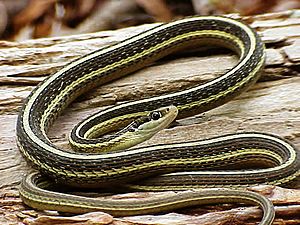Eastern ribbon snake facts for kids
Quick facts for kids Eastern ribbon snake |
|
|---|---|
 |
|
| Photo of an eastern ribbon snake | |
| Scientific classification |
|
| Kingdom: | Animalia |
| Phylum: | Chordata |
| Class: | Reptilia |
| Order: | Squamata |
| Suborder: | Serpentes |
| Family: | Colubridae |
| Genus: | Thamnophis |
| Species: | |
| Subspecies: |
T. s. sauritus
|
| Trinomial name | |
| Thamnophis sauritus sauritus (Linnaeus, 1766)
|
|
The eastern ribbon snake (Thamnophis sauritus sauritus) is a type of ribbon snake. It is one of four subspecies found in the southeastern United States. These snakes are known for their very thin bodies.
Other ribbon snake subspecies include the northern, southern, and bluestripe ribbon snakes. Some snakes that look similar are the western ribbon snake and the common garter snake.
Contents
What Does the Eastern Ribbon Snake Look Like?
The eastern ribbon snake gets its name because its body is very thin, like a ribbon. When fully grown, it can be about 18 to 86 centimeters (7 to 34 inches) long. It is a slender, black snake with a bright yellow stripe down its back. It also has a yellow stripe on each side of its body.
The snake's belly is mostly a greenish-white color. It has a brown stripe along the sides of its belly. There are also two rows of black spots between the back and side stripes. Its tail is quite long, making up about one-third of its total body length. The scales around its mouth are bright yellow or white. A light bar of white or yellow is also found in front of its eyes. Young snakes look just like the adults.
Eastern ribbon snakes are not venomous, meaning they are not poisonous. They look a bit like the common garter snake, but there are some differences. The eastern ribbon snake is much thinner. Its tail is longer, and its side stripes are on the third and fourth rows of scales. It also has pure white lips and a white mark near its eyes.
Where Do Eastern Ribbon Snakes Live?
The common ribbon snake usually lives in the southeastern United States. They prefer wet places like wetlands and areas near ponds and streams. You can find them both in and out of water. They are good at living in both environments.
When these snakes feel scared, they quickly go into the water or hide in bushes. They do not dive deep like some water snakes. Instead, they glide quickly across the surface of the water.
What Do Eastern Ribbon Snakes Eat?
Ribbon snakes mainly eat small animals. Their diet includes small fish, tadpoles, salamanders, and small frogs and toads. Sometimes, they also eat insects.
These snakes usually hunt in the morning or early evening. Once a ribbon snake sees its prey, it will quickly slither to catch it. Then, it swallows its meal whole.
How Do Eastern Ribbon Snakes Reproduce?
Eastern ribbon snakes usually reproduce in the spring. This happens in April or May, after they come out of their winter sleep (hibernation). Sometimes, mating can happen in the fall. If it does, the female snake will wait until the next spring to start developing her young.
The babies grow inside the mother for about three months. A female snake usually gives birth to about 12 young snakes. However, the number can range from four to 27 babies. Females have their babies in late summer or early fall. After birth, the young snakes are on their own. Their parents do not take care of them. Most young snakes can have their own babies after two years, but many wait until they are three years old.
Eastern Ribbon Snake Behavior
Eastern ribbon snakes are usually active all year long. However, if it gets very cold, they might need to hibernate. They often find places like ant mounds, mole tunnels, or burrows made by crayfish or muskrats to stay safe and warm.
Ribbon snakes rarely bite people if they are handled. But if they feel threatened, they can release a stinky musk from special glands. This smell helps them scare away predators.
Images for kids




